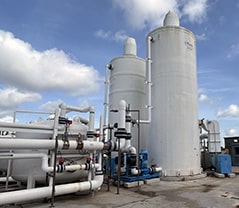 In modern industrial water treatment, advancements in technology and processes have revolutionized the way contaminants are removed from water.
In modern industrial water treatment, advancements in technology and processes have revolutionized the way contaminants are removed from water.
This blog explores the integration of NSF/ANSI 61 certified systems, artificial intelligence in water treatment, and cutting-edge processes such as decarbonation and degasification. We'll also discuss the key differences between forced draft and induced draft degasification towers, helping you make informed decisions while designing your Industrial Water Treatment System.
-
NSF/ANSI 61-Certified Water Treatment Systems: To ensure the safety and quality of water treatment equipment, NSF/ANSI 61 certification has become a crucial standard. This certification verifies that materials and components used in water treatment systems comply with health and safety requirements. When selecting a water treatment solution, opting for NSF/ANSI 61 certified systems guarantees peace of mind and adherence to the highest industry standards.
-
Harnessing Artificial Intelligence in Water Treatment: Artificial intelligence (AI) has penetrated various industries, and water treatment is no exception. Integrating AI into water treatment processes allows for more efficient and optimized operations. AI-driven systems can monitor water quality in real-time, predict system failures, optimize chemical dosing, and reduce energy consumption. By leveraging AI technologies, water treatment facilities can enhance their overall performance and streamline resource utilization.
-
Decarbonation and Degasification Systems: Decarbonation and degasification are essential processes in industrial water treatment, particularly in pH levels in water and the ability to control removing the contaminants. These processes target the removal of carbon dioxide (CO2) and other dissolved gases from water to improve its quality. Two key systems used for this purpose are the decarbonator and aeration system.
-
Understanding Degasification Towers: Degasification towers play a pivotal role in removing dissolved gases from water, enhancing its purity and quality. There are two primary types of degasification towers: "Forced Draft" and "Induced Draft."
-
Forced Draft Degasification Tower: In a forced draft degasification tower, the blower is mounted at the bottom or base of the tower. This design pulls fresh air into the blower and then pushes it into the tower. When corrosive gases, like Hydrogen Sulfide (H2S), are present, this type of tower is preferred since the corrosive gases are exhausted through the stack or possibly into a scrubber, preventing damage to the blower.
-
Induced Draft Degasification Tower: In contrast, an induced draft degasification tower has the blower mounted on top of the unit. The blower pulls air through the tower by allowing air to enter from vents located at the bottom. While this design saves space and eliminates the need for ground-mounted blowers, there is a risk when dealing with corrosive gases. If the process contains corrosive gases, such as H2S, they can be pulled through the induced draft blower, leading to damage in a short period.
-
Choosing the Right Tower for Your Industrial Water Treatment System: Selecting the appropriate type of degasification tower is crucial in designing an efficient water treatment system. If corrosive gases are present, such as hydrogen sulfide gas, a forced draft tower with fresh air intake is recommended to extend the equipment's lifespan and reduce corrosion risks. On the other hand, if corrosive gases are not an issue, an induced draft tower can be a suitable option.
Incorporating NSF/ANSI 61-certified equipment and artificial intelligence in water treatment and new water standards brings unprecedented efficiency and precision to the industrial water treatment process.
Moreover, understanding the differences between forced draft and induced draft degasification towers empowers you to make informed decisions when designing your Industrial Water Treatment System. With advancements in technology and processes like decarbonation and degasification, the future of water treatment holds promise for even more sustainable and effective solutions.
For more information or assistance with your water treatment needs, reach out to the professionals at DeLoach Industries Inc. at (941) 371-4995.




